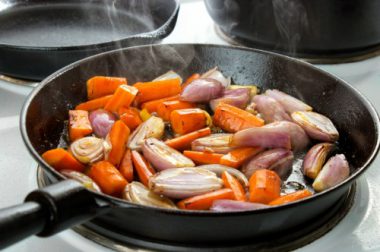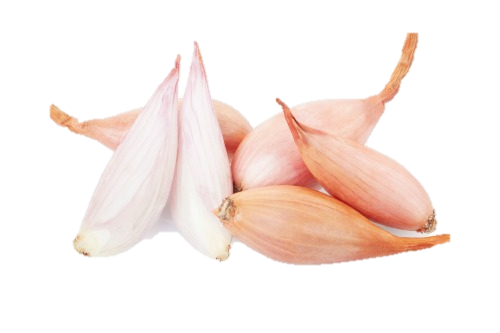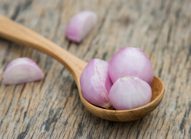Recipes we love
See all recipesFennel with white wine and shallots
An ultra-light, ultra-quick recipe with plenty of flavour, perfect for serving with a whole or fille...
Red kuri squash and shallots with honey
The sweet-and-savoury taste goes well with roasted poultry. The oil improves the assimilation of the...
Rutabagas with carrots and pistachio
This two-colour recipe is a hit with children, who love its slightly sweet taste. A good way to pers...
Health
benefits
Benefits of sulfur
A relation of garlic, shallots contain particular sulfuric substances that cause its well-known odor, sought-after flavor, and other various physiological properties that are good for your health.
Did you know? As long as the shallot is whole, it doesn’t have any effect on the nose or eyes. But, once the bulb is chopped or crushed, the damaged plant cells release an enzyme that changes sulfuric substances into strong-smelling complexes that make you tear up!
Shallots are also:
- A source of vitamin B9 (cell renewal, which is very important for pregnant women for the development of the fetus, growing children, and people recovering from illness).
- A source of vitamin B9 (cell renewal, which is very important for pregnant women for the development of the fetus, growing children, and people recovering from illness).
- A source of fiber (for good digestion, filling).
It also contains:
- Potassium
- Magnesium
- Iron
- Several antioxidants and provitamin A (beta-carotene)
Nutritional composition
When is the right time to eat them?
Year-round.
Shallots are available throughout the year, but they are in season from October to December.
Vegetable patch
or urban balcony?
Shallots are an annual plant that grows well in light, sandy soil, with good sun exposure. It doesn’t grow well in wet conditions, and should be watered lightly from time to time in very hot weather.
To learn everything you need to know about growing shallots, read the page on growing advice.
Choosing
and storing
Choosing the best shallots:
- Bulbs should be firm and should not be sprouting.
Storing your shallots:
- In a cool, dry place: Shallots last for several months when stored in a cool, dry place.
- In the refrigerator: Only when peeled, two to three days in a lunch box to preserve flavor and prevent other food in the refrigerator from absorbing the smell of the shallots.
Tips
and tricks
How to prepare shallots
Shallots can be prepared like onions, but cause fewer tears if you follow these instructions: cut it in half lengthwise, and don’t use the ‘grey’ variety, as this type causes the most tears. Slice into fine slivers.
Cooking instructions:
- 10 mins: Wok or frying pan
- 45 mins à 1h: In the oven
Anti-waste tip no.1: Don’t throw out the green stem of the shallot! It can be used like chives.
Shallots go well with:
Raw — shallots are used in vinaigrettes for many winter salads, and are ideal served with potatoes and dried fruits.
Cooked — shallots are ideal for deglazing cooked dishes, particularly meats. Shallot butter is unbeatable with skirt or flank steak.
Shallots are also used in many sauces such as béarnaise and bordelaise, etc.
Shallots are also used in many sauces such as béarnaise and bordelaise, etc.
Anti-waste tip no.2: Don’t throw out a sprouted shallot! It’s still edible and the small sprouts add a nice flavor to fromage blanc and fromage frais.
Can everyone eat it?

Young children
Shallots have a strong taste and also contain inulin, a type of fiber that can slightly irritate young digestive systems. Shallots shouldn’t be given to children under 15 months.
And everyone else
People with sensitive digestion should test out themselves how much shallot they can tolerate. It is easier to tolerate when cooked.
See plenty of other tips for encouraging children to eat vegetables
Where do they come from?
Origins and varieties
Origins
Europe is the main producer though France, the Netherlands, and Belgium.
Varieties
Shallots are part of the onion and garlic family, but have a more fragrant, less acrid flavor than either of these vegetables. The most famous types are the grey shallot, the Jersey shallot (pink shallot), and Echalion (also known as ‘banana’ shallots).



 Bell pepper
Bell pepper  Carott
Carott  Vegetable garden: sweet potato
Vegetable garden: sweet potato 










